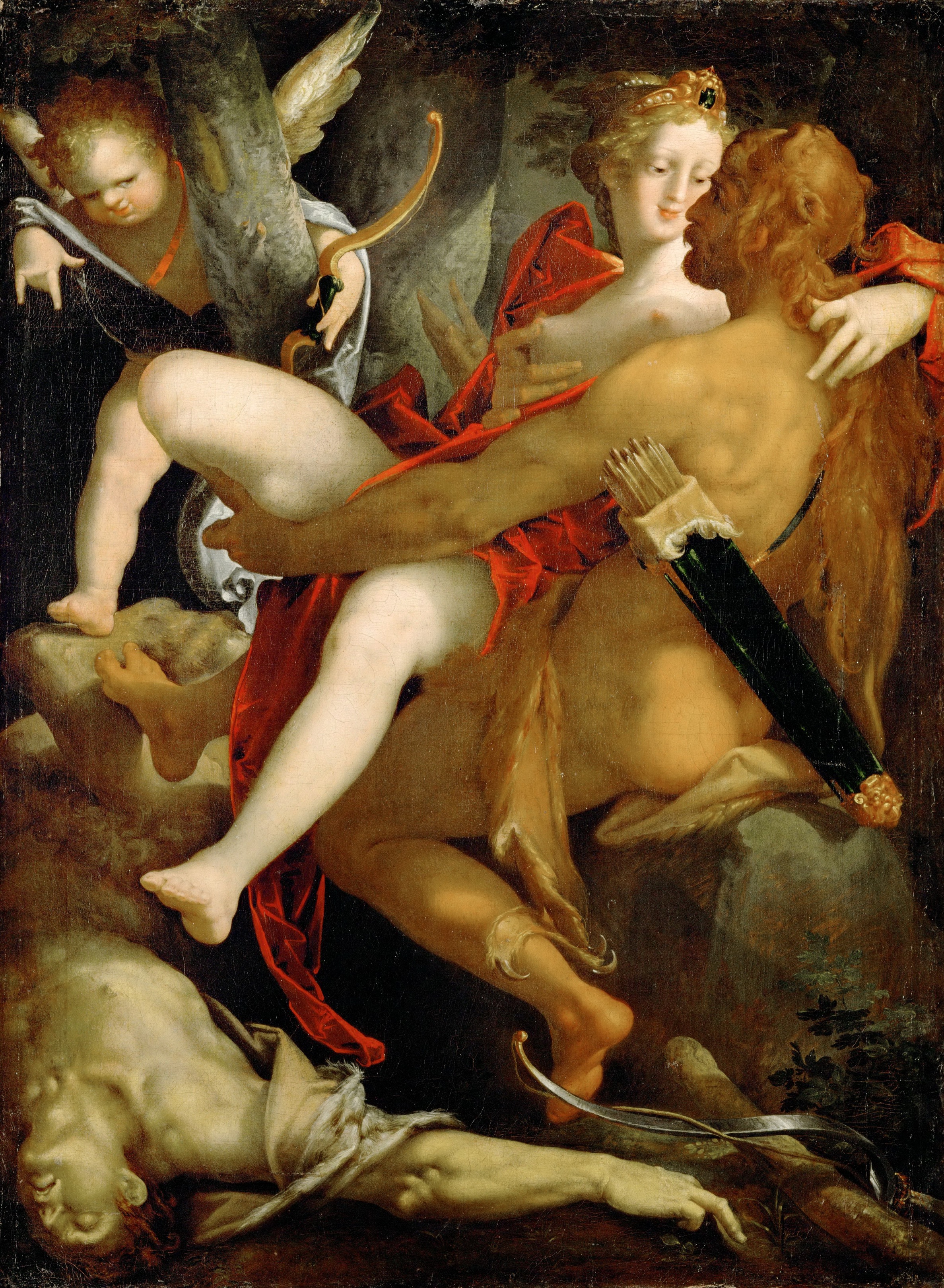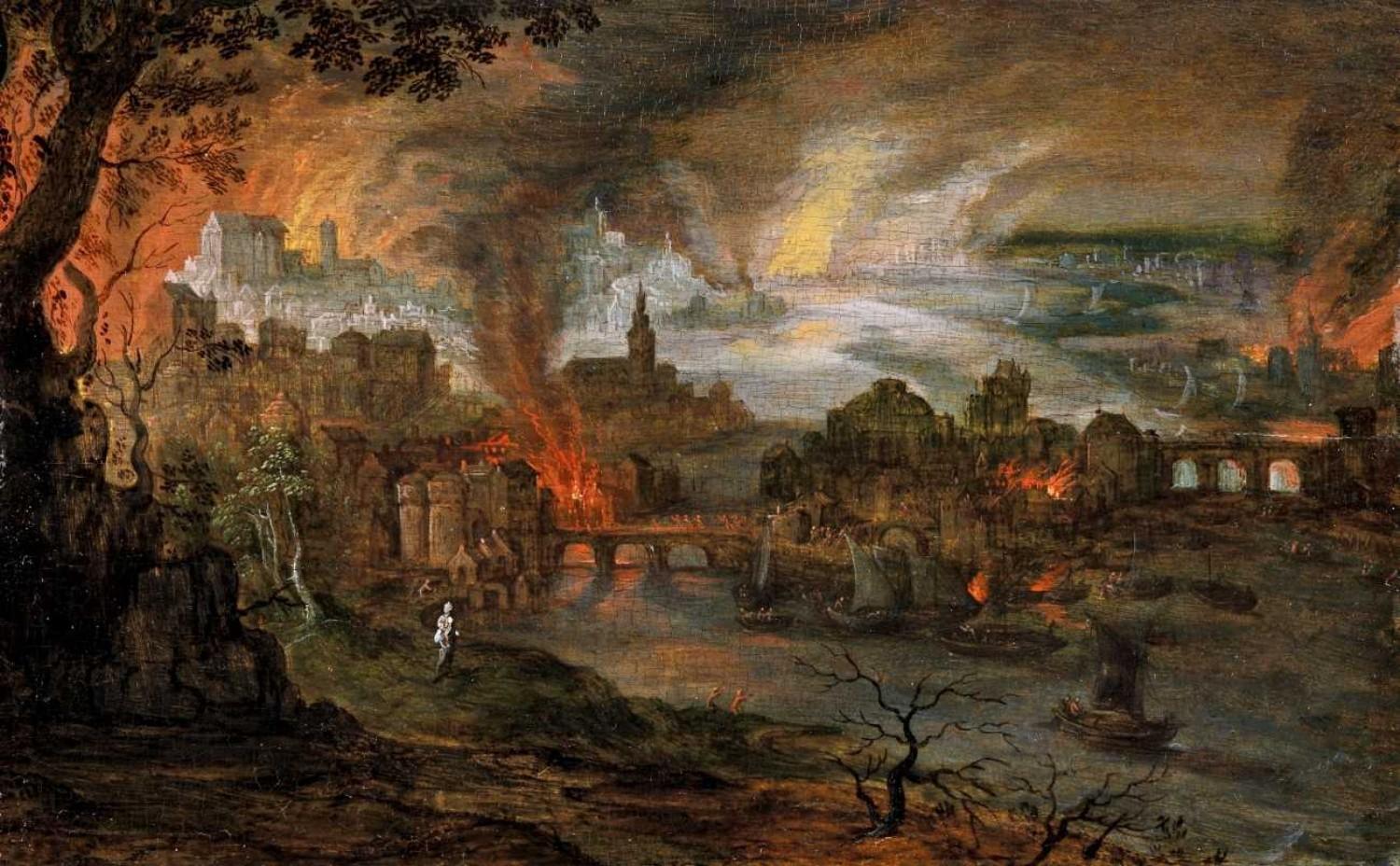|
Gillis Van Coninxloo
Gillis van Coninxloo (now also referred to as Gillis van Coninxloo II but previously referred to as Gillis van Coninxloo III) (24 January 1544 – January 1607) was a Flemish painter of landscapes who played an important role in the development of Northern landscape art at the turn of the 17th century. He spent the last 20 years of his life abroad, first in Germany and later in the Dutch Republic.Gillis van Coninxloo at the Life He was born in and studied under |
Portrait Of Gillis Van Coninxloo (II)
A portrait is a painting, photograph, sculpture, or other artistic representation of a person, in which the face and its expressions are predominant. The intent is to display the likeness, personality, and even the mood of the person. For this reason, in photography a portrait is generally not a snapshot, but a composed image of a person in a still position. A portrait often shows a person looking directly at the painter or photographer, in order to most successfully engage the subject with the viewer. History Prehistorical portraiture Plastered human skulls were reconstructed human skulls that were made in the ancient Levant between 9000 and 6000 BC in the Pre-Pottery Neolithic B period. They represent some of the oldest forms of art in the Middle East and demonstrate that the prehistoric population took great care in burying their ancestors below their homes. The skulls denote some of the earliest sculptural examples of portraiture in the history of art. Historical portraitur ... [...More Info...] [...Related Items...] OR: [Wikipedia] [Google] [Baidu] |
Willem Van Den Bundel
Willem van den Bundel (1575–1655), was a Dutch Golden Age painter. Biography He was born in Brussels and became a landscape painter, possibly as the pupil of Gillis van Coninxloo who was a witness at his wedding in Delft in 1600.Willem van den Bundel in the He moved to 1607–1620 but was back in Delft as a paying member of the during the years 1623–1654. His son died in Delft in 1642 and he sold works in Leiden 1644–1645. ... [...More Info...] [...Related Items...] OR: [Wikipedia] [Google] [Baidu] |
Schilder-boeck
or is a book written by the Flemish writer and painter Karel van Mander first published in 1604 in Haarlem in the Dutch Republic, where van Mander resided. The book is written in 17th-century Dutch and its title is commonly translated into English as 'The Book of Painters' or 'The Book of (or on) Painting' and sometimes as 'The Book on Picturing'. consists of six parts and is considered one of the principal sources on the history of art and art theory in the 15th and 16th century Low Countries. The book was very well received and sold well. Karel van Mander died two years after its publication. A second posthumous edition, which included a brief, anonymous biography of van Mander was published in 1618. This second edition was translated by Hessel Miedema into English and published in 1994-1997 together with a facsimile of the original and five volumes of notes on the text. Summary is divided into six parts that have separate title pages and are indexed. The parts are: * The f ... [...More Info...] [...Related Items...] OR: [Wikipedia] [Google] [Baidu] |
Karel Van Mander
Karel van Mander (I) or Carel van Mander I (May 1548 – 2 September 1606) was a Flemish painter, poet, art historian and art theoretician, who established himself in the Dutch Republic in the latter part of his life. He is mainly remembered as a biographer of Early Netherlandish painters and Northern Renaissance artists in his ''Schilder-boeck''. As an artist and art theoretician he played a significant role in the spread and development of Northern Mannerism in the Dutch Republic.Painting in the Dutch Golden Age - A Profile of the Seventeenth Century, National Gallery of Art, 2007, p. 119 Life Most of the information about Karel van Mander's life is based on a brief and anonymous biographical sketch included in the posthumous second edition of the Schilder-boeck published in 1618 by Jacob Pietersz Wachter. It is not certain who wrote this biographical sketch and various candidates have been proposed. Most recently it has been argued that it was written by his son Kare ... [...More Info...] [...Related Items...] OR: [Wikipedia] [Google] [Baidu] |
Liechtenstein Collection
The Liechtenstein Museum is a private art museum in Vienna, Austria. It contains much of the art collection of its owners, the Princely Family of Liechtenstein, rulers of the principality of Liechtenstein. It includes important European works of art, forming one of the world's leading private art collections. Its highlight used to be Leonardo da Vinci's portrait of ''Ginevra de' Benci'', which was acquired in 1967 by the National Gallery of Art in Washington, D.C. The museum, which was originally open to the public from the early 19th century until the Anschluss of 1938, had various locations, including the Liechtenstein Garden Palace (''Gartenpalais'') at FĂĽrstengasse 1 in Vienna's 9th District (Alsergrund), and the Liechtenstein City Palace (''Stadtpalais'') at Bankgasse 9 in Vienna's 1st District (Innere Stadt). The museum was reopened on 29 March 2004 in the Garden Palace, but after battling with low visitor numbers, it was closed for regular visiting by the public in Novembe ... [...More Info...] [...Related Items...] OR: [Wikipedia] [Google] [Baidu] |
Albrecht Altdorfer
Albrecht Altdorfer (12 February 1538) was a German painter, engraver and architect of the Renaissance working in Regensburg, Bavaria. Along with Lucas Cranach the Elder and Wolf Huber he is regarded to be the main representative of the Danube School, setting biblical and historical subjects against landscape backgrounds of expressive colours. He is remarkable as one of the first artists to take an interest in landscape as an independent subject. As an artist also making small intricate engravings he is seen to belong to the Nuremberg Little Masters. Biography Altdorfer was born in Regensburg or Altdorf, Lower Bavaria, Altdorf around 1480. He acquired an interest in art from his father, Ulrich Altdorfer, who was a painter and miniaturist. At the start of his career, he won public attention by creating small, intimate modestly scaled works in unconventional media and with eccentric subject matter. He settled in the free imperial city of Regensburg, a town located on the Danube Ri ... [...More Info...] [...Related Items...] OR: [Wikipedia] [Google] [Baidu] |
World Landscape
The world landscape, a translation of the German ''Weltlandschaft'', is a type of composition in Western painting showing an imaginary panoramic landscape seen from an elevated viewpoint that includes mountains and lowlands, water, and buildings. The subject of each painting is usually a Biblical or historical narrative, but the figures comprising this narrative element are dwarfed by their surroundings. The world landscape first appeared in painting in the work of the Early Netherlandish painter Joachim Patinir (c. 1480–1524), most of whose few surviving paintings are of this type, usually showing religious subjects, but commissioned by secular patrons. "They were imaginary compilations of the most appealing and spectacular aspects of European geography, assembled for the delight of the wealthy armchair traveler", giving "an idealized composite of the world taken in at a single Olympian glance". The compositional type was taken up by a number of other Netherlandish artists, m ... [...More Info...] [...Related Items...] OR: [Wikipedia] [Google] [Baidu] |
Northern Mannerist
Northern Mannerism is the form of Mannerism found in the visual arts north of the Alps in the 16th and early 17th centuries. Styles largely derived from Italian Mannerism were found in the Netherlands and elsewhere from around the mid-century, especially Mannerist ornament in architecture; this article concentrates on those times and places where Northern Mannerism generated its most original and distinctive work. The three main centres of the style were in France, especially in the period 1530–1550, in Prague from 1576, and in the Netherlands from the 1580s—the first two phases very much led by royal patronage. In the last 15 years of the century, the style, by then becoming outdated in Italy, was widespread across northern Europe, spread in large part through prints. In painting, it tended to recede rapidly in the new century, under the new influence of Caravaggio and the early Baroque, but in architecture and the decorative arts, its influence was more sustained. Backgro ... [...More Info...] [...Related Items...] OR: [Wikipedia] [Google] [Baidu] |
Roelandt Savery
Roelant Savery (or ''Roeland(t) Maertensz Saverij'', or ''de Savery'', or many variants; 1576 – buried 25 February 1639) was a Flanders-born Dutch Golden Age painter. Life Savery was born in Kortrijk. Like so many other artists, he belonged to an Anabaptist family that fled north from the Spanish-occupied Southern Netherlands when Roelant was about 4 years old and settled in Haarlem around 1585. He was taught painting by his older brother Jacob Savery (c. 1565 – 1603) and Hans Bol. After his schooling, Savery traveled to Prague around 1604, where he became court painter of the Emperors Rudolf II (1552–1612) and Mathias (1557–1619), who had made their court a center of mannerist art. Between 1606 and 1608 he traveled to Tyrol to study plants. Gillis d'Hondecoeter became his pupil. Before 1616 Savery moved back to Amsterdam, and lived in the Sint Antoniesbreestraat. In 1618 he settled in Utrecht, where he joined the artist's guild a year later. His nephew Hans w ... [...More Info...] [...Related Items...] OR: [Wikipedia] [Google] [Baidu] |
Pieter Schoubroeck
Pieter Schoubroeck, or Schaubroeck (ca.1570 – May 10, 1607), was a German landscape painter of the Frankenthal school. Biography Schoubroeck was born at Hessheim. His father was of Flemish origin and his mother Clarken de Wale was also from the Southern Netherlands. According to the RKD he was active in Italy in 1595, Neurenberg in 1597-1600, and moved to Frankenthal in 1601.Pieter Schoubroeck in the He painted landscapes and is considered a member of the school of Frankenthal. The school of Frankenthal included the painters , |
Jan Brueghel The Elder
Jan Brueghel (also Bruegel or Breughel) the Elder (, ; ; 1568 – 13 January 1625) was a Flemish painter and draughtsman. He was the son of the eminent Flemish Renaissance painter Pieter Bruegel the Elder. A close friend and frequent collaborator with Peter Paul Rubens, the two artists were the leading Flemish painters in the first three decades of the 17th century. Brueghel worked in many genres including history paintings, flower still lifes, allegorical and mythological scenes, landscapes and seascapes, hunting pieces, village scenes, battle scenes and scenes of hellfire and the underworld. He was an important innovator who invented new types of paintings such as flower garland paintings, paradise landscapes, and gallery paintings in the first quarter of the 17th century.Kolb, 2005, p. 1 He further created genre paintings that were imitations, pastiches and reworkings of his father's works, in particular his father's genre scenes and landscapes with peasants. Brueghel represen ... [...More Info...] [...Related Items...] OR: [Wikipedia] [Google] [Baidu] |
._by_Andries_Jacobsz._Stock.jpg)




_060.jpg)

.jpg)



